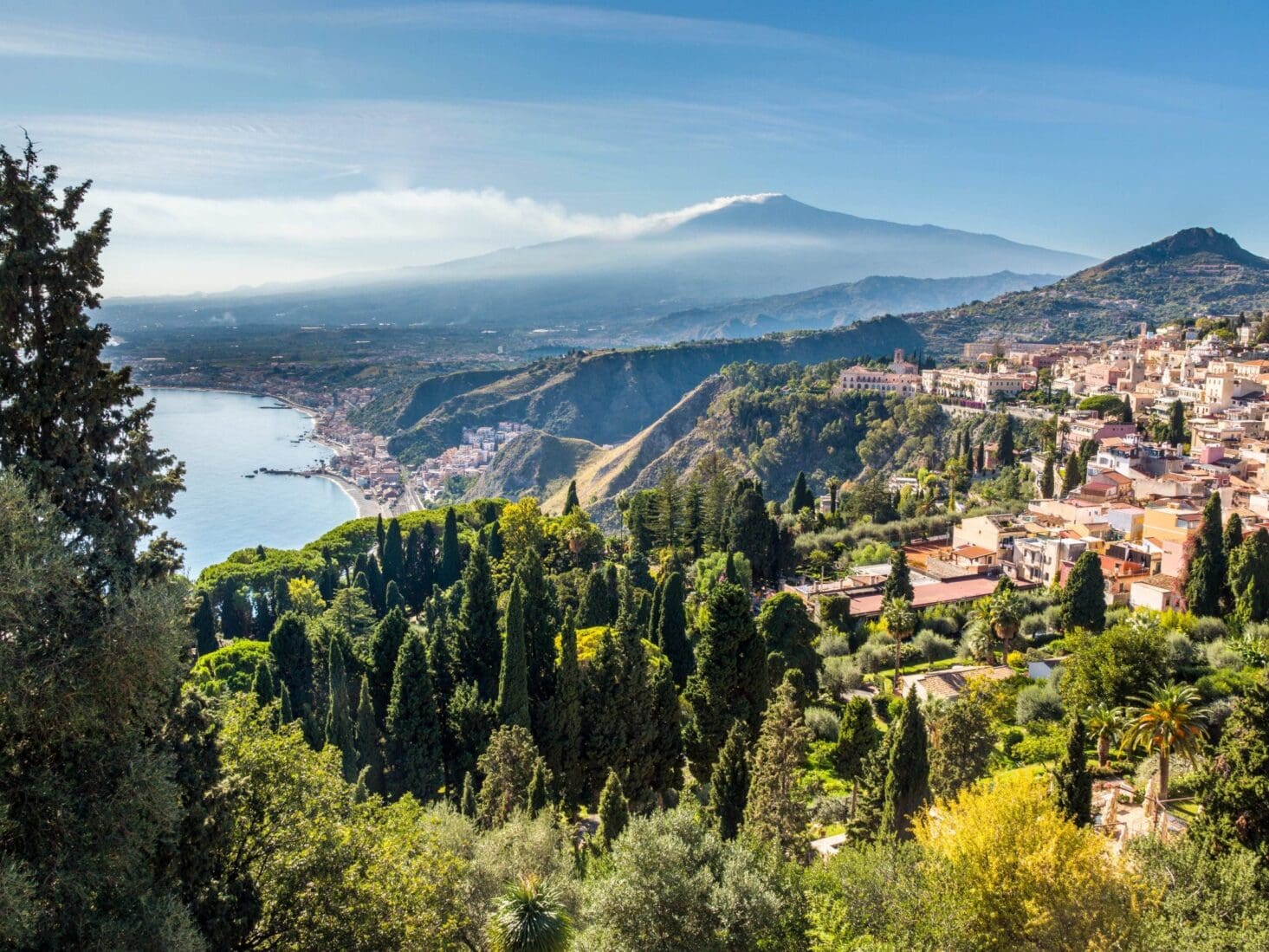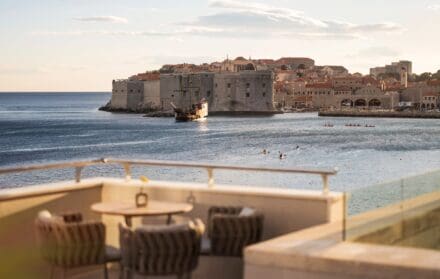
A road trip around Sicily – making the most of the Mediterranean’s largest island
‘By turns a pitchy cloud she rolls on high, by turns hot embers from her entrails fly, and flakes of mounting flames, that lick the sky. Oft from her bowels massy rocks are thrown, and shivered
The best view in Sicily is a steep, sticky, cacti-lined climb, one hour if you’re fit, and not hungover from all the Limoncello the night before, from an ancient stone archway at Porta Messina, the portal into Taormina, the island’s prettiest town, that curls and twirls passed 17th-century chapels, iron-age cave-tombs, abandoned 1990s ice-cream parlours and groups of thick-calved Americans dressed for Augusta. The hike climaxes in castellated Castelmola, a tiny medieval village perched atop a precipitous Acropolis-like outcrop of rock. It’s here you’ll find Bar Turrisi – a higgledy-piggledy café-cum-bar religiously devoted to jumbo-sized representations of the male member.
Like stars in the night’s sky, the more you look the more you see. From phallic figurines to priapic bronze statues to full-on, lob-on-shaped beer pumps, Bar Turrisi is a five-storey temple to the tallywacker. They’re carved into candles and table lamps and door handles and armchairs and fountains and bar stools and balustrades and staircases and sinks and taps and anything else that can be manscaped into something that resembles a membrum virile. Even inconspicuous-looking floor tiles are arranged in such a way as to reveal, from certain angles, representations of, well, you know what. The bar’s got serious wood.
The turn-too-quickly-and-have-your-eye-poked-out phallicism is the vision of Peppino Turrisi, an eccentric ex-actor who inherited the bar from his father who had inherited it from his father. Bar Turrisi opened as a souvenir shop that sold almond wine in 1947, a year after war-torn, poverty-stricken Sicily had become an autonomous region of the new Republic of Italy.

By the 1970s, tourist numbers were up and when Peppino and his wife had three sons in five years one body part came to represent their patriarchal lives more than any other – an emblem that has symbolised joy and fertility in Sicily since the Greeks began arriving in the eight century BC.
Over the ensuing years, Peppino and his sons have commissioned so much phallic-related furniture that an even greater hoard of oblong-shaped objets d’art remains hidden behind closed doors. A visitors’ book, packed full of cartoon drawings of the full package, invites guests to leave their own meat-and-two-veg inspired artwork. More than 100 volumes, stretching back to the seventies, are supposedly stacked out back.
Once you’re done taking dick pics, a circular iron staircase winds itself to a rooftop terrace that serves Sicily in all its blue-sea-meets-active-volcano glory. The view stretches from the Ionian coast in the east to Mount Etna and the Bay of Giardini-Naxos in the south, and the from Cape of Sant’Alessio and the strait of Messina in the North, to, on a clear day, the Calabrian coast of mainland Italy. It’s completely worth the genuinely tough-at-times hike.

East Sicily – Castelomola, Taormina, Modica, Ragusa and Noto

Tiny Castelmola, home to said penis emporium, serves as a time capsule for Sicily in general. After the Greeks came the Romans came the Byzantines. It was the Byzantines who first fortified Castelomola around 800AD. In 831, Northern African Arabs successfully invaded Sicily, claiming Taormina and Castelmora in 902. For more than two centuries, Sicily operated as an Arabo-Islamic emirate, a multicultural colony made up of Arab and Berber Muslims, Jews and Greek Orthodox Christians.
The Norman Conquest, led by swashbuckling Hauteville cousins Robert Guiscard and Roger I – who’d recently claimed Calabria and Apulia – began in 1061. Palermo fell in 1072, its mosque, originally built as a Byzantine basilica, converted into a catholic church. Castelmola fell six years later, the Normans building a castle on top of the original Byzantine walls. The ruins that remain today are thought to date back to 1334, when the Castle of Mola – hence Castelmola – was remodelled as a prison. Sicily, by this point, was back under the control of the French, having being ruled by Germany’s House of Hohenstaufen between 1194-1268.
Today, Sicily is a collection of grand coastal cities – Taormina, Palermo, Syracuse, Catania, Messina, Agrigento – and dying interior towns. Linking them is a network of sweeping autostrada, much of it dramatically elevated on elegant viaducts, most of it empty, some of it good, some of it crummy, all of it fast, and vast strips of it, heartbreakingly, lined with industrial levels of rubbish. Renting a car is the only option.
Below Castelmola in uptown Taormina is Villa Ducale. Once the summer residence of a local nobleman, since 1993 the property has been run as a 19-bedroom guesthouse by husband-and-wife hoteliers Andrea and Rosaria Quartucci. The Quartucci’s interest in turning this steeply-tiered collection of patio-ed bedrooms into one of the town’s top boutique hotels runs deeper than straight-up financial gain. The property was previously owned by Rosaria’s mother, who lived there until 1990. Things here are personal.
“We want our guests to relax in the scent of Sicily,” says Gaia Quartucci, Andrea and Rosaria’s daughter. “Our elegant home is ideal for those who dream of spending a holiday wrapped in the thousand little attentions that are the signature of any great hotel.”


Spread out over multiple levels, Santorini-style, Ducale is a series of verandas linked by a labyrinth of fairly-lit walkways. All roads lead to an expansive terrace, around which the rest of the hotel is arranged. Cocktail are strong, sunsets spectacular, breakfasts sublime. There’s a small pool and a free shuttle service to and from central Taormina below.
When German landscape artist Otto Geleng exhibited his paintings of Taormina at an art gallery in Berlin in the 1860s, critics refused to believe the scenes he depicted were real. “Come to Sicily,” Geleng challenged his detractors, “and if Taormina differs from my paintings, I’ll pay for your journey and your accommodation. Otherwise, you will write of the town’s beauty in your newspapers.”
In 1872, Geleng was elected deputy mayor of Taormina, a position he held for 10 years. He married a local, had a daughter and opened an atelier in the middle of town. Despite all of this, during the First World War, Geleng was charged with being a citizen of the enemy. He was sent to a prison of war camp in Bronte and only released once the war was over. Geleng returned to Taormina, where he died in 1939. Today, a Michelin-starred restaurant in the Belmond Grand Hotel is named after him.
Ernest Hemingway wrote his first short story in Taormina, aged 19. D H Lawrence began writing Lady Chatterley’s Lover while living in the town. It is rumoured that the story was inspired by Lawrence’s wife and her liaisons with a Sicilian mule diver. Taormina is something from a novel, a movie, a film set made to look like the quixotic Medieval Italian coastal-village-on-a-cliff you have in your head. The Ancient Greeks built an amphitheatre here (the second largest in Sicily). Two thousand years later, in the 1890s, English conservationist Florence Trevelyan created what is now a splendidly-kept, hillside public garden. Trevelyan also owned Isola Bella, a small island in a W-shaped bay that has become one of Sicily’s most photographed beauty spots. It’s here that Ristorante Pizzichella serves knock-out pistachio gnocchi for €12 a pop.
On a hill in the crook of a hairpin bend next to some Roman ruins somewhere between Isola Bella and Corso Umberto – Taormina’s main cobbled boulevard – is Villa Carlotta, another stately-home-turned-boutique-hotel from the Quartuccis. Rooms, of which there are 23, are more opulent here, with gilded mirrors, elaborate headboards and freestanding antique wardrobes. There’s a bigger pool and arguably even better views. Breakfast is Sicily in pies, pastries and mounds of pistachios served as Mount Etna, snow-capped and cartoonishly conical, broils in front. You can see from where Geleng’s unbelievers were coming.


The rest of Sicily isn’t Taormina. The Mediterranean’s largest island is Italy’s poorest region. Sicily’s budget deficit is on par with that of Greece. Unemployment is among the highest in Europe. Youth unemployment was flitting around 50 per cent, even before Covid-19. Earthquakes in the south-east and allied bombing in the north and south have reduced areas of cities to ruin.
The worst earthquake to hit Sicily struck in 1693. It destroyed more than 70 towns and claimed the lives of an estimated 60,000 people. South-east Sicily was severest hit. The destruction wrought prompted a rebuild of biblical proportions. Whole cities were recreated, some on their original sites, others moved completely.
Towns such as Modica, Ragusa and, most spectacularly of all, Noto were redesigned around central squares lined with impressive churches and grand palaces. The Late Baroque Towns of the Val di Noto are now a UNESCO World Heritage Site. You can do most of the area in a day, though it’s a rush.
South and south-west Sicily – Agrigento, Sciacca, the Valley of the Temples and the Archaeological Park of Selinunte

Three hours to the west of Noto is the town of Agrigento. Agrigento owes its place on the map largely thanks to its proximity to the Valley of the Temples, the largest archaeological site in the world. The valley spans 257 acres and comprises eight temples dating back to the fifth century BC. Modern Agrigento is a sun-kissed sink estate arranged around a sand-coloured Old Town, a would-be paradise ruined by concrete tower blocks and a lack of public money. We stopped for lunch because we had to.
Less than one hour to the west is the much prettier Sciacca, a bubbling, hill-top spa town that soothed the aches and pains of invading settlers and American tourists for almost 2,500 years. Its last baths shut down in 2015 owing to a chronic lack of money.
Sciacca is most famous for a Romeo-and-Juliet-type feud between the Catalan house of Luna and the Norman house of Perollo that began in the early 1400s. Triggered by Giovanni Perollo’s love for Margherita Peralta, soon-to-be wife of Don Artale Luna, the grudge divided Sciacca in two, prompting a tit-for-tat civil war that raged for more than a century. The quarrel, which is said to have claimed the lives of half the city’s population, only ended in 1529 when a descendant of Giovanni’s, Giacomo Perollo, was stabbed to death and dragged around the city tied to the tail of a horse. Sigismondo Luna, Giacomo’s rival, fled to Rome, where he committed suicide by jumping into the Tiber River. A plaque in a piazza marks the spot of the stabbing.

Sciacca’s main business today is fishing. A Norman castle, a smattering of 15th and 16th century churches, and some fine squares and palaces justify a visit.
Forty minutes further to the west is the archaeological park of Selinunte. Selinunte was one of the most progressive cities in Magna Graecia, until the Carthaginians attacked in 409BC. Almost overnight, the city was reduced to rubble. An estimated 16,000 citizens were killed. Many of the rest were sold into slavery. The ruins that remain are as impressive as anything in the Valley of Temples and far more time-effective to navigate. Tour guides scoot you between ruins in electric buggies.
Northern Sicily – Erice, San Vito Lo Capo and Palermo

Erice, to the north, was named by the Greeks after King Eryx, the love child of Aphrodite and Butes the Argonaut, with whom the goddess of love had an affair to make Adonis jealous. Eryx was a famed boxer, until Heracles beat him to death. Erice is one of the highest towns in Sicily. It is named in Virgil’s Aeneid, which he wrote between 29 and 19 BC. The Arabs changed the city’s name to Gebel-Hamed. The Normans called it Monte San Giuliano. Mussolini changed it back to Erice, so as to celebrate the city’s glorious past.
Online tour guides don’t tend to talk about Erice. We learned of it through a friend. A maze of Mediaeval cobbled streets conceals 60 churches. The Arabs started building Pepoli Castle in the 10th century. The Normans most impressive effort was the Castle of Venus. Erice is often covered in cloud. The fog makes the eerie streets even spookier.
Sicily isn’t a beach holiday. The best we found was the horseshoe bay at San Vito Lo Capo, 45 minutes from Erice. San Vito Lo Capo is a white-sand shore served by a buzzy, low-slung tourist town. It has a pretty, palm-tree promenade and is framed by the dramatic Monte Monaco mountain. San Vito Lo Capo is Sicily’s answer to Copacabana, minus the rip currents and caipirinhas.

When Palermo fell to the Normans in 1072, it was the culmination of a decade-long campaign that saw the invading army overcome far more than heavily fortified walls. In 1064, one contemporary chronicler recorded, the besiegers were best by a plague of tarantulas. ‘Anyone who was stung by them found himself filled with gas and suffered so much that he was unable to keep the same gas from coming out his anus with a disgusting rattle.’
Palermo Cathedral, the largest on the island, is Sicily wrought in masonry and marble. A medieval church built on a Muslim mosque built on a Byzantine basilica (there’s a passage from the Koran engraved on a column near the entrance). Work began in 1184 and for the next six centuries the building was updated and added to so as to create a melange of about every architectural style imaginable.
Inside the cathedral are the tombs of Roger II (1095-1154), two Holy Roman Emperors – Frederick II (1194-1250) and Henry VI (1165-1197) – and the hedonistic hermit king, William II (1153-1189). To get there by car you must navigate a ring fence of unforgiving autostrada followed by a maze of nerve-shredding side streets. We almost gave up.


Greater Palermo is populated by around 1.2 million Palermitani – more than one fifth of Sicily’s five million inhabitants. It’s a dense, decrepit city, washed out, weirdly Havana-like, more Middle-Eastern than European. It was heavily-bombed during the Second World War, never fully rebuilt, pillaged in the decades since by corrupt politicians and organised crime. Near Zisa Castle is the Catacombs of the Capuchin friary. Around 8,000 embalmed corpses lay in various stages of decomposition. Some are hung by their necks and put out on display. Others are arranged as if for a photoshoot. Two mummified children sit on a rocking chair. Photos are strictly forbidden.
Legend has it that the cathedral at Cefalù, one hour to the east, was Roger II making good on a promise he’d made to God. Having become unstuck while sailing through a storm, so the fable goes, the Sicilian king beseeched the Almighty for his divine intervention. To demonstrate his gratitude, Roger avowed, he’d construct a great cathedral on whichever spot God saw fit to deliver him to safety. As luck would have it, God chose to spit Roger out at Cefalù, a strategically-located, geographically-fortified, historically-significant stronghold in the middle of the important trading towns of Messina and Trapani. How’s your luck?

Cefalù is a one-hour drive east of Palermo and the only town that comes close to matching the aesthetic charm of Taormina. A warren of cobbled streets worn smooth by ancient sandals and modern espadrilles, the town begins at the bottom of a cliff and winds its way down to a sandy beach lined with restaurants and souvenir shops. You can stand in a turquoise sea and look back at a Medieval city that hasn’t changed for the best part of half a millennium. It’s quite something.
Work on Roger’s cathedral commenced in 1131 and faltered on for 109 years. By which point the great unifier king had been dead for 77 years, his body entombed within a crypt at the Cathedral of Palermo. Last year, the twin towers of Cefalù Cathedral were opened to the public for the first time. Connecting the towers is an elevated corridor from which you can view the best-preserved Byzantine mosaics in Sicily, as well as sections of a floor that date back to the 1st century. If ancient Christian-Arabic architecture is your thing, it might be useful to know that the cathedrals of Cefalù, Palermo and Monreale are considered some of the greatest examples anywhere in the world. Handily, they’re all within an hour’s drive of each other.
Mount Etna – The Mother Mountain

Back in the East, Etna marks the spot where the African and Eurasian plates collide – though Northern Italians aren’t talking tectonics when they refer to Sicily as the start of Africa. It doesn’t look so big, Europe’s largest volcano, until you begin the climb.
Etna is sliding into the Ionian Sea, though it’s in no rush. A cable car takes you as high as it can, over a ghostly ski resort of dead black coral. It’s either a two or four-hour hike from there, depending on which crater you’re headed for, and how close you want to get. The ladybirds are carried up by the wind, their bright wings pinpricks of red against the mountain’s scarred black sides. They breed and they die. Hard hats and hiking boots are provided at the bottom. Heed the warnings, take a fleece. Mount Etna is extraordinary. One minute you’re on the moon, the next you’re floating in cloud.
Double superior rooms at Villa Ducale start from €249 per night, Villa Ducale; Double deluxe rooms at Villa Carlotta start from €299 per night, Villa Carlotta









